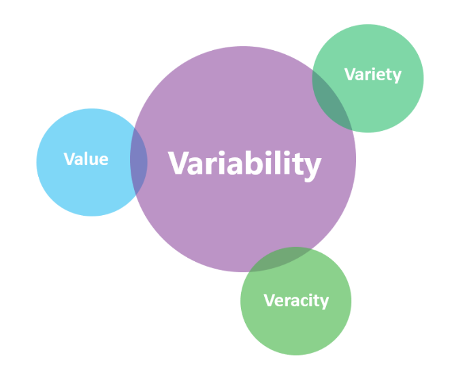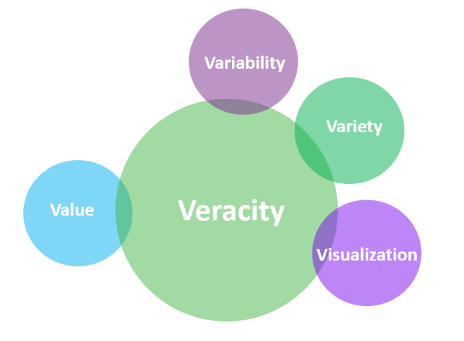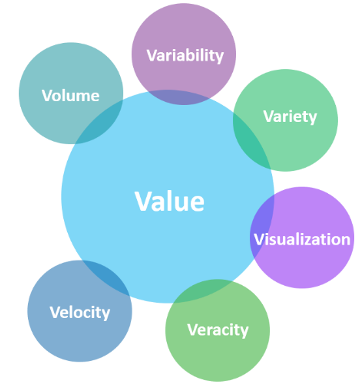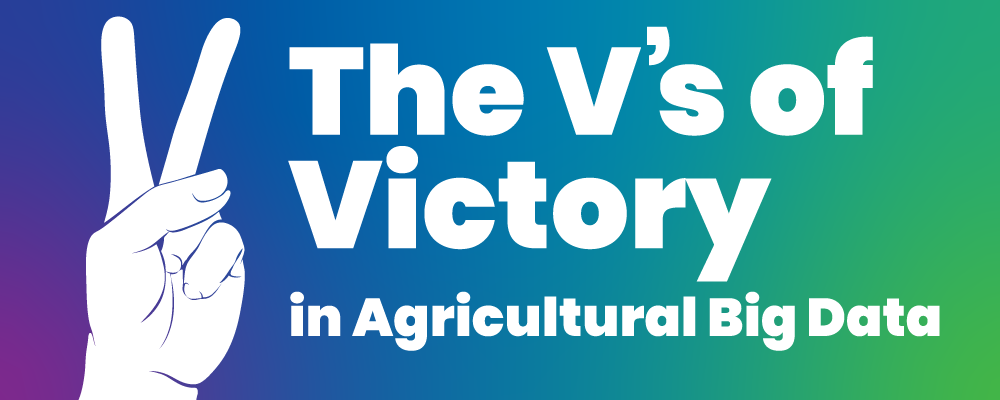Introduction
As farmers and ranchers, we all have at least heard of the term data, it started as pen-to-paper stuff we collected routinely, filed, and reviewed, now it includes sensors, cameras, robots, and software, which are producing data in ever more ways, amounts, types and places from across the farm, that we must look at daily.
As producers and ranchers begin to integrate their current generation of data systems into a single farm data ecosystem, allowing for ownership controls, enhanced business intelligence, security, and centralization of their data, there are new terms and information that we need to begin to understand and get comfortable with around quantifying and qualifying agricultural big data, while utilizing it as a resource that we can gain diverse values from, both on and off the farm.
The V’s of agricultural big data are Volume, Variety, Veracity, Variability, Velocity, Visualization, and Value. These Seven V’s of agricultural big data are interconnected and in many cases interdependent. Understanding how these apply to our agricultural systems will make us victorious in overcoming our challenges of sustainability, traceability, and a life worth living for all livestock production animals. As we build out your farm-specific centralized data ecosystem, we need to begin to understand how the Seven V’s apply to the systems you have today on-farm and the ones that you will need/ plan for in the future that aid in the objectives and areas of concern or challenge for your farm or ranch.

Beginning to use combined integrated farm data as a source of intelligence will allow farm teams access to more information and insights to be able to make quicker and more accurate decisions, based upon specific animal or farm needs.
Big data is an information technology term defined as the amount of data that gets more bulky, complex, and fast-moving that becomes very difficult to handle through normal database management tools. Thus, the need to create farm-level data ecosystems.
The use of big data alone without the agriculture or agricultural descriptor in front means that the data will be of lesser quality. It is important to recognize that many businesses are data-rich, yet information-poor. Data is the raw input that we transform into useful information for making informed decisions and provides us with ongoing monitoring of business performance. This means we need big data, but we also need to know the context of the data from around the farm, this is what will create value and where on-farm teams can assist.
With the number of AgriTech systems increasing on your farm or ranch, we need you and your team to understand how the Seven V’s of big data apply to your data systems. This process begins by understanding the data you have by:
- Auditing your current farm data systems
- Understanding what specific data systems you have on-farm
- What they do, and what data they collect, then rank the data on how critical it is to your decision-making for your business today
- Identify the data you would like to have that is currently not part of your data ecosystems.
- Finally, beginning to understand the seven V’s of big data and apply each to the data systems you have on your own list.
The Seven V’s
Volume
Today you might already think you have volumes of data, but we need to get to the bottom of where these volumes of data are coming from and what is their individual and total combined volume and quantity. How much in total is the volume of your farm’s data and which systems are producing the largest amounts of data, this will allow us to begin to quantify your data. From there we can build a scalable data ecosystem infrastructure, for both current and future needs.
Volume, as an interconnected component of big data that should continually be increasing, and is a component that is deeply linked to Variety, Velocity, Veracity, Variability, and Value.

Variety
This aspect of Agricultural Big Data refers to the different types of data points that can be collected, including the widening range of data types and data sources that are available and that need to be handled. Imagine the Variety of different data points that are coming from around your farm or ranch today, whether that is the barn, the parlor, the field, outside environment, milk tank, the cow’s data, these areas on the farm may include Structured vs. Unstructured data, images, video, etc.
The more of the right Variety of data the greater the Value and the Visualizations that can be created; that ultimately helps the farmer and rancher achieve their core aims and objectives on-farm while increasing the desirability of your data being used off the farm by others.
Variety is closely linked to Variability and Veracity and how we capture this in the care and management of livestock is important.

Variability
The way care is provided to any given animal depends on all kinds of factors, this may also include the day, season, and how the staff member enters the data or how that data is collected. Such variability means data can only be meaningfully interpreted when the context of what intervention or treatment, at what location and animal, performed by a staff member under certain conditions are accurately collected and recorded. Still somewhat elusive in animal health care data, variability remains a constant challenge as no two farms or animals are the same, but this remains an opportunity in improving our ability for earlier detection and informed intervention.
Variability of the data is closely interconnected with the Variety and Veracity of data, and it adds greater context to what is happening on the farm or ranch. This is ultimately closely linked to the Value of the data.

Veracity
Data Veracity refers to the quality of data that is to be analyzed. The quality of data is dependent on certain factors such as; where the data has been collected from, how it was collected, missing data, and how that data will be analyzed. The Veracity of a user’s data dictates how reliable and significant the data really is. Transparency around data Veracity is becoming more important as we incorporate and trust more digital tools to assist us on-farm or on-ranch. Data Veracity Transparency is imperative to further grow trust in digital and data systems, especially for the data owner.
This is importantly linked with Visualization, Variability, and Variety, which increases Value.

Velocity
This aspect refers to each data component and how frequently that data component is generated and transmitted or reported. The increasing speed of data transfer, arrival, and processing will increase the capability to understand and respond to events as they occur, even in real-time situations, which is our aim at the farm level.
How often do you get the data point and how quickly do we receive that data file or data point? This is something we need to know as we build intelligence, while also an approach that all Internet of Things (IoT) devices and platforms need to continue to improve, share information on and implement standard protocols within their products. This will increase the overall Value of the data and the ability to greatly develop enhanced Visualizations and business intelligence.
This is closely linked to Visualization, Volume and greatly connected to Value.

Visualization
All data has a story and how we tell that story is in how we present and visualize the data. We can see numerous tools available in this area like Qlik, Power BI, Tableau, Google Data Studios, etc. that have built tools so we can simplify this process and these off the shelf components that can be applied to producers’ data ecosystems quickly, thereby allowing the farmer or rancher owners/ manager to work with their team to define what report and visualization work for their business, support staff, and underlying data systems.
This is how we get the staff to see what is going on and develop a greater understanding of how to read the data and improve digital literacy levels, a critical component if we are to keep up the pace with the digital revolution in agriculture. Visualization is deeply linked to the Value of the data, while Variety and Variability, and Velocity of the data are critical components we must take into account.

Value
Last but not least, big data must produce Value. Value is predicated on each of the other six V’s. Working to increase the potential of each of these across your farm will increase the Value of your data—monetarily, yes, but also in regards to business intelligence and insights.
Value is also acutely linked to the overall Veracity of the data. Without Veracity, there is no value, which the quality of is predicated on understanding the seven V’s of agriculture big data.

To Conclude
The Seven V’s of big agricultural data need to be a strategy in the forefront of producers’ and ranchers’ minds with their current data systems, but also something that needs to be employed as they begin to think about future data systems that fit into their business needs, challenges and opportunities.
Bringing together all data systems on-farm into a single farmer-owned data ecosystem allows for centralization of your data and the understanding and the beginning of how we increase and enhance the Seven V’s of Big data and allow us to set a direction specific to your farm and operation’s needs.
This will take learning digital systems and becoming digitally literate, but the great thing is that you are already using these systems in more simplistic and often disparate forms today, we just need to illuminate these data points, understand the team’s capabilities and technologies, then sculpt the tools to the needs of your team from your data ecosystem and put you on your path toward digital transformation.
Visualization is an important component of all farms and is equal to Value at this stage of our agricultural revolution. Getting producers’ digital literacy levels to a basic level is critical and possible. “Civil data scientists” and “civil data engineer” are now real roles. We just need to make the interfaces intuitive to the user’s needs. Therefore, basic digital literacy is critically important to our industry. We need these civil data engineers and civil data scientists on our farms. They, in essence, will be the farmers of the future.
Building farm data ecosystems with the Seven V’s in mind will allow producers to be victorious in having a scalable data system allowing for ownership, enhanced business intelligence, security, and centralization of their data that fits their needs and challenges and that is ever-changing and enhancing. This strategy will not only help producers and ranchers but also rural communities and economies while allowing us to strive for a life worth living for all livestock animals.

